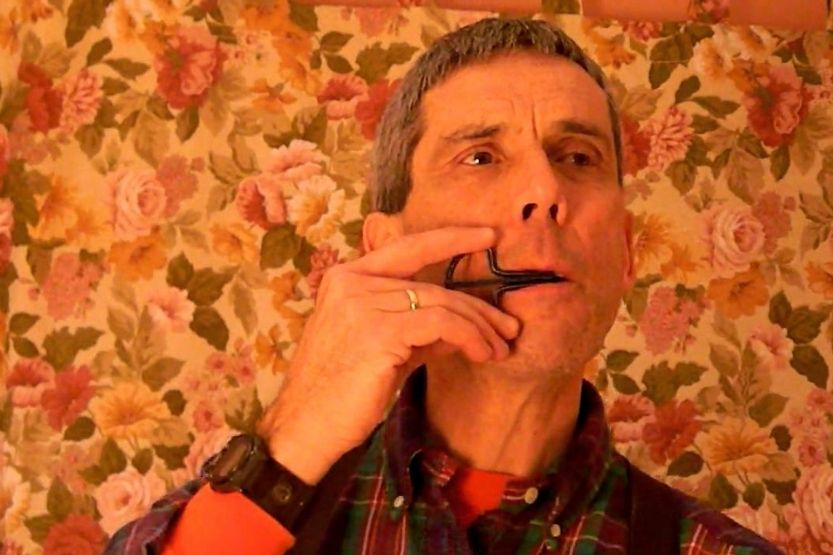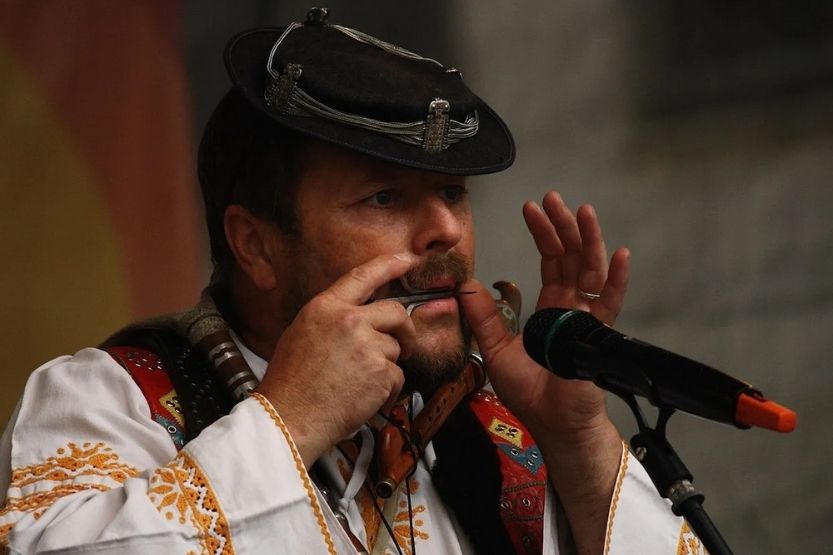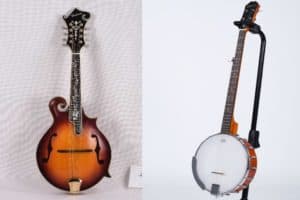You can play the jaw harp easily by just putting it against your mouth. But if you want to play music with it, shape the sounds and get the right tunes, you need to know how to play jaw harp.
To play the harp, you need to put it in your mouth. You should place it in between your teeth. When you put the jaw harp on your teeth, don’t close your mouth completely. Hold the frame of the harp properly with your three fingers. Your thumb and middle fingers should hold the bottom part of the instrument, while your index finger should hold its top.
The jaw harp is also called a mouth harp because you play it using your mouth. Just by looking at this instrument, you will assume that it’s straightforward to play. However, if you want to play good music with it, you have to learn how to produce good sounds.
Read on to learn more about how to play jaw harp, the fundamentals of how it should be played, and some tips on how you can create good music with it.
Also, we hope you find the links here useful. We may get a commission if you purchase something through a link on this page, so thank you!
How to Play Jaw Harp

Playing the jaw harp is very simple. Just put it in your mouth, and you can produce sounds from this instrument. The jaw hard should be placed in between your teeth. And you must hold the frame of the instrument with three fingers of your left hand.
Your thumb and middle finger should hold the bottom of the instrument, and your index finger should hold the top of the frame. You will use your mouth and throat as the resonator. When you change the shape of your mouth, and if you pluck the instrument’s tongue, you will produce sounds.
You can create different melodies with this instrument by using the above techniques, applying appropriate breathing techniques, and using different rhythms. When playing the jaw harp, your mouth or lips should always be slightly opened so that the reed or tongue of the instrument can swing through them unobstructed.
Safety First
You should always follow the ‘ safety first ‘ procedure since using your teeth to play the jaw harp. The sounds that you hear from this instrument are coming out from its reed. When you pluck it, it vibrates through the frame while holding it in between your slightly opened teeth or mouth.
Mouth or Oral Cavity Serves as the Resonator
The tongue or reed of the instrument vibrates inside your mouth. Your mouth or oral cavity serves as the resonator. This is where you can modulate or vary the sound. You can do it by changing the size of your mouth cavity.
Different Sounds Produced Using Plucking Techniques
And when you apply different plucking techniques to the reed and different breathing techniques, you can produce different sounds and rhythmic effects.
As you progress in your learning, you will be tempted to try different techniques to create the sounds you want. This is when you always need to follow the safety first procedure whenever you play this instrument.
Safest Way to Play a Jaw Harp
Don’t be like the person who busted his tooth on one side by playing the jaw harp carelessly. One of the safest ways to play this instrument is by putting two parallel bars, one against the top and another against the bottom of your teeth.
Apply Enough Pressure
Then give enough gap or space so that the instrument’s reed can pass through them without any trouble. You should also apply just enough pressure on the tongue so that it will not vibrate excessively.
So, in playing the jaw harp, it is not just simply putting it in between your teeth and vibrating its reed. You need to practice safety first to avoid losing any of your front teeth. But don’t worry, just as long as you do it correctly, you won’t be harmed.
Choose the Right Harp

Before learning how to play the jaw harp, you should first choose the right jaw harp to use. Not all jaw harps are the same. There are good ones, and there are not-so-good ones. You can find a good inexpensive jaw harp, but you can also find an expensive one that’s not good.
Click here to see this Jew’s Harp by P.Potkin in a wooden case on Amazon.
Too Heavy or Too Stiff Jaw Harps
Generally, jaw harps in the price range between $5 and $10 are too heavy or stiff. They are heavier because they are made of thicker metal, so they are dangerous to play with. Since their reeds are thicker, they have a hard time flexing and cannot vibrate enough as well.
And since their reeds are thicker and heavier, if they smack your teeth, you can break a tooth or two. In addition, these cheap jaw harps are not loud enough. So, they can’t produce great sounds because they are, sad to say, poorly done.
Invest to Get a Real Good Jaw Harp
So, if you want to protect your teeth and play a jaw harp, you need to invest an extra amount to get a real good jaw harp that is reasonably priced enough for your kind of budget. Get a good jaw harp, even if it will cost you a few more dollars.
Click here to see this Grover Jaw Harp on Amazon.
Lightweight Jaw Harps Are Available
There are good jaw harps that cost only $20 or less. They are lightweight, made of good quality materials, and, more importantly, they sound a lot better. Their reeds are thinner, so they are a lot safer to play. Please note that they come in different sizes, so pick the one you think will suit you best.
How to Properly Play the Jaw Harp
Click here to see this Jaw Harp by MUARO P.Potkin in Dark Wooden Case on Amazon.
Now that you know the need for the right jaw harp to ensure that it is safe to play and produces great sounds, you are now ready to learn the basics of how to play it. The following steps will serve as your guide:
1. Hold the Instrument Correctly
Pinch Grip
The first thing you should know is the correct way of holding a jaw harp. For beginners, the pinch grip is recommended. This grip will give you the ideal stabilization that you need at this point.
The thumb and middle finger of your left hand should pinch the bottom of the instrument at its wider portion. Your index finger should hold the top of the frame, but it should not press the harp down.
As you develop your playing skills, you may want to vary your grip on this instrument. Some of the grips variations that you may want to consider include alternate pinch grip or cradle grip:
Alternate Pinch Grip
Grip the harp on the frame’s upper left side with your pointy finger and your thumb. This grip has an advantage over the pinch grip because you can use your middle finger to mute the harp by tapping its reed. However, this grip is less stable than the pinch grip.
Cradle Grip
You will be ‘cradling’ the instrument if you use this grip. But you should not squeeze the top and bottom of the frame at the same time. If you do, you will hear a clinking noise.
2. Hold the Jaw Harp in Your Mouth
To hold the harp in your mouth, slightly open your lips. It must have an open space that the reed can swing through. It may help if you take note of the width of the reed so that you can adjust the opening of your mouth.
Now, put the harp inside your lips. If the harp is bow-shaped, it should also touch your incisors. You can now pluck the reed with the fingers of your right hand if your left-hand fingers are holding the harp’s frame.
3. Pluck the Reed
Once you pluck the reed, the harp will produce its fundamental note or prime note. This is the sound that you will continuously hear while you are playing the instrument. It is the primary note that you can modify if you will change your oral cavity.
If you change your resonance chambers, you will create and amplify different overtones or variations of this primary note. So, by playing this instrument, you can create different note pitches and tone colors.
Again, how to play a jaw harp? You can safely play a jaw harp by putting it between your teeth. Don’t close your mouth completely. Meanwhile, hold the harp’s frame using your three fingers, with your thumb and middle finger supporting the harp’s bottom. Then, your index supporting the top of the harp.
Tips on Playing the Jaw Harp

If the jaw harp has caught your interest, and you want to play it decently, here are some tips that you need to follow:
1. Get the Correct Placement
The right placement of the harp inside your mouth makes a lot of difference. To do it correctly, you should firmly place the inner frame of the instrument against the top and bottom of your teeth. In effect, you are using your skull as a counterpoint for the instrument.
You should hold the jaw harp firm enough so that it won’t rattle when you pluck its reed. But you should also hold it light enough so that you are not straining your jaw. Then place the instrument so that it is covering about 50% to 75% of your mouth. The right side of your mouth should also be open.
2. Make the Right Seal
The quality of the sound that the jaw harp produces will depend on the seal that you will make with your lips. Your mouth serves as the resonance chamber of this instrument as the reed vibrates between the parallel bars of the instrument’s inner frame.
If the seal is not good enough, the sound it will produce will not be as good and as loud as you want it to be. The reason is that your mouth is not echoing the vibrations as much as it should.
3. Pluck the Tongue or Reed Correctly
There are many ways you can strike the trigger or tongue of the harp. You can pluck it with your index finger, or you can move the trigger by moving your wrist or even your whole arm. Striking it with the side of your index finger is also one way of doing it.
To do this, your wrist should be dangling loosely, and your elbows should be at the level of your head. This is a more advanced plucking technique that is called double striking. But being a beginner, you should practice plucking the reed first.
4. Shape the Sound with Your Tongue
The easiest technique in producing sounds from a jaw harp is to move your tongue around and to vary its shape. Changing the shape of your mouth will vary the overall sounds and the harmonics of the harp.
At the start, try to get your mouth into a position where you can say the AH vowel. Then pluck the harp a couple of times to experience how the sound is produced. After doing that, change the shape of your mouth so you can say the EE vowel.
Then repeat these vowel sounds and move your mouth back and forth between all vowel sounds so that you can get the feel of the various sounds that the harp can produce. You can also try saying the vowels A-E-I-O-U and see what happens to the sounds.
5. Breathe Through the Instrument
You need to catch your breath while playing the jaw harp. The way to do this is to breathe through the instrument. Practice breathing in and breathing out while you are playing the jaw harp until you get the hang of it.
Conclusion: How to Play Jaw Harp
The only way you can play a jaw harp is by putting it in your mouth. You have to put it in between your teeth. Don’t close your mouth completely when you are holding the instrument with your teeth.
Hold the frame of the harp properly with the three fingers of your left hand. Your thumb and middle fingers should hold the bottom part of the instrument. Your index finger should hold that top of the frame.
But just playing the jaw harp is different from making good music with it. There are different ways to produce different pitches and tone colors. You should learn the required skills to really play the jaw harp and produce good music from it.
Related reading:
How Many Strings Does a Harp Have?
Banjo Vs Ukulele – What Are the Differences?














